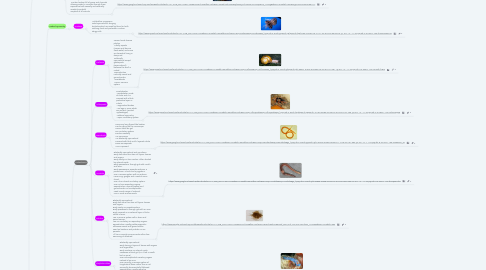
1. Prokaryote
2. Alage
2.1. Single-Cellular
2.1.1. Archea
2.1.1.1. Micro organisms that are similar to bacteria in size and simplicity of structure but radically different in molecular organization.
2.1.1.1.1. Archaebacteria
2.1.2. Bacteria:
2.1.2.1. A member of a large group of unicellular micro organisms that have cell walls but lack organelles and an organized nucleus, including some that can cause disease.
2.1.2.1.1. Eubacteria
2.2. Plants
2.2.1. Autotrophic (photosynthesis) -Cell walls made of cellulose -Store food in the form of starch -Sessile : cannot move from place to place -Lives primarily in terrestrial environments
2.2.1.1. Gymnosperms
2.2.1.1.1. a vascular plant that produces seeds in special structures called cones Cones are the reproductive structures - produce either pollen or ovules Woody trees - have needles or scale-like leaves Include coniferous trees such as pines, spruce, cedars, junipers
2.2.1.2. Lycophytes & Pterophytes: The Ferns
2.2.1.2.1. Lycophytes (club mosses) and Pterophytes (ferns) are a group of VASCULAR, SEEDLESS plants Have vessels to transport food and water (xylem and phloem) They have roots, stems or leaves
2.2.1.3. Bryophytes: The Mosses
2.2.1.3.1. Simplest of plants NON-VASCULAR, SEEDLESS plants Have protective cuticles and stomata for gas exchange no true leaves or roots E.g. mosses, liverworts and hornworts terrestrial and aquatic
2.2.1.4. Angiosperms
2.2.1.4.1. Angiosperms form the largest group of living plants Plant that produces flowers and fruit Flower is the specialized reproductive structure - produces pollen and/or ovules Seed are enclosed in fruit Divided into monocots and dicots Examples: lemons, mango, roses, peas, sunflower, apples, corn
2.2.1.5. Dicots
2.2.1.5.1. Have 2 seed leaves (cotyledons), Net veins on leaves ,Flowers have 4-5 parts Taproots, Vascular tissue arranged in a rings. Examples: trees and ornamental flowers
2.2.1.6. Monocots
2.2.1.6.1. Have 1 seed leaf (cotyledon) Parallel veins on leaves Flowers are in multiples of 3 Fibrous roots Vascular tissue scattered Example: lilies, onions, corn, rice, sugarcane
2.2.2. Plant Propagation: is the process of creating new plants from a variety of sources
2.2.2.1. Seeds
2.2.2.2. Cutting
2.2.2.3. Bulbs
2.2.2.4. Plant Parts
2.2.3. POLLINATION
2.2.3.1. Self Pollination - The pollination of a flower by pollen from the same flower or from another flower on the same plant.
2.2.3.2. Cross Pollination- transfer of pollen (male gamete) from one plant to the female reproductive organ of another plant
2.2.3.3. Animal Pollination - pollen grains are carried from one plant to another by birds, insects and animals.
2.2.3.4. Wind Pollination - pollen grains are carried from one plant to another by wind.
3. Eukaryote
3.1. Single-Cellular
3.1.1. An organism that consists of only one cell
3.1.1.1. Protist
3.1.1.1.1. -Part of the biological Kingdom called the Protista. -First Eukaryotes -predecessors of modern protists and multicellular eukaryotes - animal, plant and fungi. -Their cells have a nucleus and organelles -Organelles probably developed when the cell membrane of a prokaryotic ancestor folded in on itself.
3.2. Multi-Cellular
3.2.1. An organism that consists of more than one cell
3.2.1.1. Fungi
3.2.1.1.1. classifications
3.2.2. Animlas
3.2.2.1. Colonial Choanoflagellates Ancestor
3.2.2.1.1. No Nerves
3.2.2.1.2. Nerves
3.2.2.2. Arthropods
3.2.2.2.1. Crustacea
3.2.2.2.2. Myriapoda
3.2.2.2.3. Arachnida

